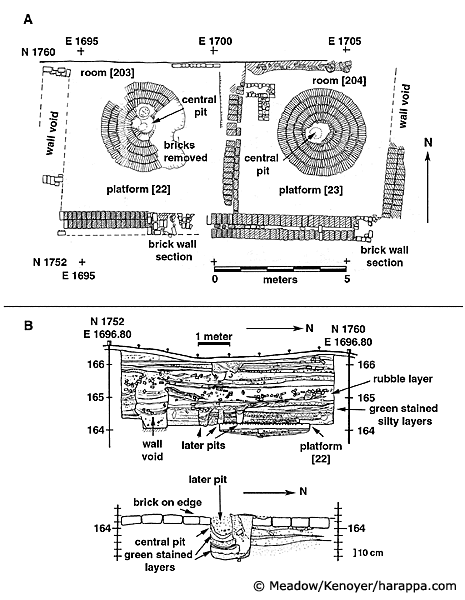Harappa Phase Occupation: Circular Working Platforms and Mound E, Southwest
The circular working platforms located to the south of the "granary" or Great Hall are also among the best known features at Harappa. During his excavations, Vats identified 17 circular brick platforms (Vats 1940:19ff) and in 1946 Wheeler excavated an 18th example (Wheeler 1947). Earlier interpretations about the circular platforms suggested that they were used for husking grain and that they may have had a central wooden mortar. In the 1998 excavations one additional circular platform was located and detailed documentation and sampling was conducted to determine its function and chronology.

Figure 8. Harappa 1998, Mound F, Trench 43: A plan of circular platforms; B sections of sediments above platform [22] and section through central pit..
The new platform and the one discovered earlier by Wheeler were both situated inside nearly square rooms measuring approximately 5.5 m on a side (Figure 8). The walls of these rooms were originally made of baked brick built on top of mud-brick foundations. The brick walls were between 90 cm and 1 m wide and had been robbed down to the level of the mud-brick foundation, but the central parts of the room where the circular platforms were situated remained undisturbed by the brick robbers. Detailed documentation of the stratigraphy and features in the levels above the platforms revealed that the rooms continued to be used after the construction of the platform. The new excavations did not reveal any evidence for grain processing and there was no evidence for a wooden mortar in the center. Some straw impressions were found on the floor to the south of the circular platform, but microscopic examination by Dr. Steve Weber confirmed that these impressions were of straw and not of chaff or grain processing byproducts.
Additional areas adjacent to the newly discovered platform were opened up in 1998 through 2000 to investigate the nature of the Period 3C occupations and to locate the western perimeter wall of Mound F (Meadow, Kenoyer and Wright 1998; Meadow, Kenoyer and Wright 1999; Meadow, Kenoyer and Wright 2000).
Most of the baked-brick walls in this area have been robbed, but occupational deposits, including living surfaces and house floors, are intact. Numerous inscribed objects were discovered in 1999 including a spectacular seal with the unicorn motif and a long inscription in the Indus script. Measuring 5.2 x 5.2 centimeters square, this is one of the largest seals found at Harappa and is in almost perfect condition (Figure 4.3). Such seals would have been used by powerful officials, merchants or landowners to seal goods and documents. Many small inscribed and molded tablets have also been found in this area during the last two years of excavations. These tablets may have been used as credit tokens or amulets.
Mound E, Southwest
Excavations along the southwestern edge of Mound E were undertaken in 2000 to examine the earliest occupation of the Harappa phase (Period 3A) and to investigate specific craft activity areas. After surface scraping it was possible to discern numerous mud brick structures and lines of walls, pits and hearths. Removal of the final traces of gully erosion revealed a large complex of rectangular rooms made of mud brick, with small divider walls and intervening streets or alley ways. The baked brick walls built above these mud brick structures had been removed by the brick robbing. The houses in the lower area of excavation appear to belong to the initial phase of the Harappan period (3A) on the basis of painted pottery and specific vessel shapes that are similar to the Early Harappan pottery. Further up slope are the remains of structures dating to Period 3B and at the top of the slope are deposits of Harappan Period 3C. Some traces of Period 4/5 (Late Harappan) are found at the top of the mound and Late Harappan pottery is found in some of the erosional gully debris. The objectives of the excavations were to understand the nature of the earliest urban phase architecture, the pottery and other artifacts, specialized crafts and the use of seals and writing.
The erosional layers overlying the in situ structures contained many exquisite stone beads, terracotta beads and bangles, gold beads, some crucibles, touchstones, and other materials related to crafts such as bead making and shell working. The high concentration of these objects in this part of the site suggests that there may be a major craft area near by or in the levels to the east in the center of Mound E. A large number of faience molded tablets and incised steatite tablets were also recovered from the erosional layers in this part of the site, but no inscribed tablets or seals were found inside any of the rooms or in the associated street deposits of the Period 3A occupation layers.
During the final days of the 2000 excavation it was possible to sample one area of the slope that had large quantities of frothy vitreous slag mixed with bone and some steatite fragments. The excavations of this area revealed several distinct layers of "faience slag" with canisters and large quantities of complete and broken faience beads. Among the beads were also some faience inscribed tablets and vitrified faience wasters that indicate dump from a primary production area. This discovery of a faience workshop dump with both beads and molded faience tablets is extremely significant as it suggests that both types of objects were being made by the same craftspeople.
{Reprinted by permission from: Meadow, R.H. and J.M. Kenoyer (2001) Recent discoveries and highlights from excavations at Harappa: 1998-2000. INDO-KOKO-KENKYU [Indian Archaeological Studies] 22: 19-36.}
